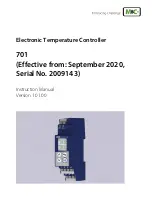
Becker VRP-CH Series Valve Regulator Pilot Instruction Manual | 17
Copyright 2023 Baker Hughes Company. All rights reserved.
PS Series Non-Bleed Sensor:
Achieves non-bleeding conditions in either full open or
full closed positions. Selection based upon power gas
pressure and discharge gas pressure. See Page 7 for
initial pilot adjustment information.
Note:
DPS series sensors must be used with Becker
CV series globe valves.
VB Series Volume Boosters:
Provides additional volume capacity to the VRP-CH
for use with large volume control valve
actuators. The VB series volume boosters
also may be used for applications that
require additional operating speed. The
VB-250 volume booster offers no adjust
-
ments. All adjustments to the boosters’
response are controlled through the pilot
orifice and sensitivity drum. Refer to the
pilot initial adjustment procedures for
further information.
PS-2 Series Sensor Adjustments
1. Turn the adjusting screw of the PS-2 sensor clockwise
until it extends about 1
3
/
4
-inch from the top of the spring
cartridge.
2. Adjust the VRP-CH according to the pilot adjustment
procedures.
For a normally open regulator (monitor):
3. Bleed off the sensing pressure.
4. Wait until the pressure reading on the cylinder top gauge is
equal to power gas.
For normally closed (standby) regulator:
5. Increase the sensing pressure 5 percent above setpoint.
6. Wait until the pressure reading on the cylinder bottom
gauge is equal to power gas.
7. Turn the adjusting screw of the PS-2 sensor counterclockwise
until the exhaust port of the VRP-CH stops bleeding gas.
Then turn the adjusting screw an additional half turn in the
same direction.
8. The pressure sensor is now set for the existing supply
pressure. If the supply pressure to the VRP-CH is changed,
the sensor must be reset. Refer to the pilot initial adjustment
procedures for further information.
Troubleshooting
If the volume boosters bleed gas even when the control valve
is not moving, or if the control valve continually cycles, turn the
pilot sensitivity adjustment drum to the left (increasing numbers
on the scale) by small increments until stability is achieved and
the exhaust ports of the volume boosters do not bleed gas. To
help ensure maximum sensitivity of the system, make the control
valve slightly unstable by turning the pilot sensitivity adjustment
drum to the right (decreasing numbers) and then turn it back to
the left (increasing numbers) by small increments until stability
is achieved.
Accessories
The following accessories are available to enhance the
operation or provide additional features to your VRP-CH
series double-acting pilot control system. For additional
information regarding a specific VRP-CH accessory, contact
Baker Hughes.
SP Series Setpoint Change Pump:
Provides a simple and accurate method of
applying false signal pressure during initial
adjustment of the VRP pilot. The pump
can provide a false signal pressure of 10
percent to 20 percent in excess of working
pipeline pressure, eliminating the need for
nitrogen bottles or electronic calibration
devices.
Remote Setpoint Module:
Provides remote adjustment of VRP-B
pilot setpoint via an electrical signal.
Standard input signals are 24 VDC pulse
and 120 VAC pulse. A 4-20 mA input
signal motor is available. All motors
provide 4-20 mA setpoint feedback.
AB Series Atmospheric Bleed Control:
Maintains minimum pressure differential
across the cylinder. AB control is required
to provide the necessary output to
operate the control valve under all design
conditions. See Page 7 for adjustment
information.
NBV Series No Bleed Valve:
Achieves non-bleeding conditions at
both full open and full closed positions
without any adjustment. Selection
based upon power gas pressure and
discharge gas pressure.
Содержание Becker VRP-CH Series
Страница 1: ...VRP CH Series Valve Regulator Pilots Instruction Manual Rev A Baker Hughes Data Classification Public...
Страница 30: ...30 Baker Hughes Copyright 2023 Baker Hughes Company All rights reserved Part Silhouettes...
Страница 34: ...34 Baker Hughes Copyright 2023 Baker Hughes Company All rights reserved Notes...
















































